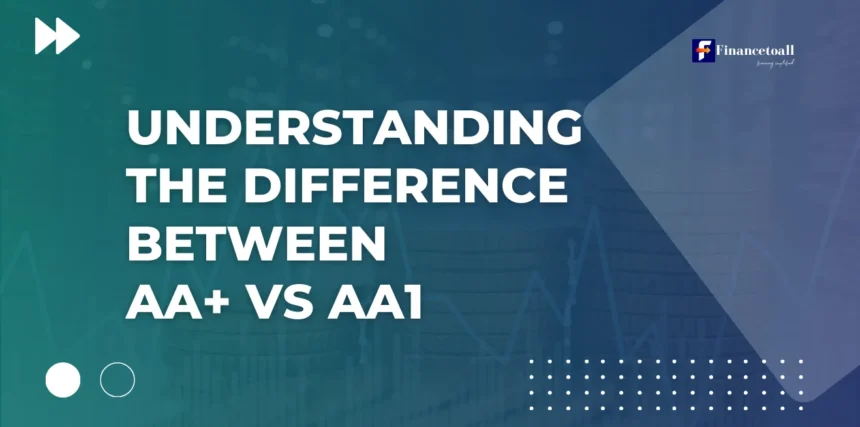Comparing Bond Ratings: AA+ vs Aa1
Bond ratings are critical tools in assessing the creditworthiness of issuers, whether they are governments or corporations. These ratings guide investors in evaluating the risk associated with bond investments, influencing decisions on risk and return. Two of the most recognized bond ratings, AA+ from S&P Global Ratings and Aa1 from Moody’s Investors Service, sit just below the top-tier AAA/Aaa ratings, signaling strong financial health and a low risk of default. Here’s a detailed comparison of these two ratings.
Overview of Rating Agencies
- S&P Global Ratings and Moody’s Investors Service are two of the major credit rating agencies in the world. They assign ratings to bonds based on an issuer’s ability to meet its financial obligations.
- Rating Scales: Both agencies use a similar scale, where AA+ (S&P) and Aa1 (Moody’s) represent high credit quality, just a step below the highest possible ratings of AAA and Aaa, respectively.
Understanding AA+ (S&P) and Aa1 (Moody’s) Ratings
- AA+ Rating (S&P): This rating indicates that the issuer has a very strong capacity to meet its financial commitments. It is considered a high-grade bond, with a very low probability of default, though slightly more susceptible to adverse economic conditions than AAA-rated bonds.
- Aa1 Rating (Moody’s): Similar to S&P’s AA+, Moody’s Aa1 rating signifies a high-quality bond with very low credit risk. It reflects the issuer’s strong financial health and reliability in meeting its debt obligations.
You can also read: Impact of A- and A3 Credit Ratings in Financial Market
You can also read: Significance of an Aa2 Credit Rating
Differences in Methodology
- S&P’s Approach: S&P typically emphasizes quantitative financial metrics, including debt levels, coverage ratios, and other measurable financial factors. Additionally, qualitative factors such as the effectiveness of management and the issuer’s market position are considered.
- Moody’s Approach: Moody’s methodology often places more weight on long-term economic stability, market position, and structural factors affecting the issuer’s ability to meet its obligations.
Both agencies may assign an outlook to their ratings (e.g., “negative” or “positive”), indicating their view of the issuer’s future credit trajectory.
Implications for Investors
- Risk and Return: Bonds rated AA+ Vs Aa1 are both considered low-risk investments, though not entirely risk-free. These ratings suggest a minimal risk of default, making them attractive to conservative investors seeking stability.
- Investment Strategies: Investors might include AA+ and Aa1 rated bonds in portfolios designed for capital preservation, as these bonds offer a good balance of safety and return, particularly when compared to lower-rated bonds.
Market Perception and Impact
- Investor Confidence: The market generally perceives bonds rated AA+ and Aa1 as very secure, with a high degree of confidence in the issuer’s ability to repay. These ratings often lead to strong demand, particularly in times of economic uncertainty.
- Yield Differences: While the yield differences between AA+ and Aa1 rated bonds are usually minimal, even small variations can impact large-scale institutional investments, influencing decisions on where to allocate funds.
Case Studies and Examples
- Examples: Governments of stable economies, large multinational corporations, and well-established financial institutions often carry AA+ or Aa1 ratings. For instance, a blue-chip company like Microsoft might have bonds rated AA+, while a sovereign nation like Germany might hold an Aa1 rating.
- Performance Analysis: Historically, AA+ and Aa1 rated bonds have shown resilience during economic downturns, maintaining value and providing steady returns when lower-rated bonds might struggle.
Potential for Rating Changes
- Factors Leading to Upgrades or Downgrades: Various factors could lead to a change in these ratings, such as significant changes in the issuer’s economic environment, shifts in management, or unforeseen events like political instability or major financial crises.
- Impact of Rating Changes: A rating upgrade typically leads to an increase in bond prices and a decrease in yields, reflecting increased investor confidence. Conversely, a downgrade might lead to a decline in bond prices and higher yields as the perceived risk increases.
Conclusion
In summary, AA+ Vs Aa1 ratings both indicate a high level of creditworthiness and low risk, making bonds with these ratings attractive to risk-averse investors. However, subtle differences in the methodologies of S&P and Moody’s, along with the potential for slight yield variations, mean that investors should carefully consider their specific investment goals and risk tolerance when choosing between these bonds.
FAQ: Understanding Bond Ratings – AA+ vs. Aa1
Q.1 What are bond ratings?
Bond ratings are evaluations provided by credit rating agencies to assess the creditworthiness of an issuer, such as a corporation or government, and their ability to repay debt. These ratings help investors gauge the level of risk associated with purchasing a bond.
Q.2 Who assigns AA+ and Aa1 ratings?
AA+ ratings are assigned by S&P Global Ratings (Standard & Poor’s), while Aa1 ratings are provided by Moody’s Investors Service. Both are leading credit rating agencies that evaluate the financial health of issuers.
Q.3 What do AA+ and Aa1 ratings signify?
Both AA+ and Aa1 ratings indicate high credit quality, just below the highest possible ratings of AAA (S&P) and Aaa (Moody’s). These ratings suggest a very low risk of default and a strong ability to meet financial obligations.
Q.4 Are AA+ and Aa1 ratings equivalent?
Yes, AA+ (S&P) and Aa1 (Moody’s) are generally considered equivalent in terms of credit quality. They both reflect a high level of financial stability and reliability, with only minor differences in risk assessment.
Q.5 What is the difference between S&P and Moody’s methodologies?
S&P focuses more on quantitative financial metrics, such as debt levels and coverage ratios, along with qualitative factors like management effectiveness. Moody’s places greater emphasis on long-term economic stability and structural factors affecting the issuer’s ability to meet its obligations.
Q.6 How do these ratings affect bond yields?
Bonds with AA+ and Aa1 ratings typically offer slightly lower yields compared to lower-rated bonds because they are considered less risky. The differences in yield between AA+ and Aa1 bonds are usually minimal but can influence large-scale investment decisions.
Q.7 Why are bond ratings important to investors?
Bond ratings provide crucial information about the credit risk associated with a bond. Investors rely on these ratings to make informed decisions, balancing the potential return against the likelihood of default.
Q.8 Can bond ratings change over time?
Yes, bond ratings can be upgraded or downgraded based on changes in the issuer’s financial condition, economic environment, or other factors. Such changes can significantly impact bond prices and yields.
Q.9 What factors could lead to a rating upgrade or downgrade?
Factors that might lead to a rating upgrade include improved financial performance, stronger economic conditions, or better management. A rating downgrade could result from increased debt levels, economic downturns, or other negative events.
Q.10 Should I choose bonds with AA+ or Aa1 ratings?
Choosing between AA+ and Aa1 bonds depends on your investment goals and risk tolerance. Both ratings represent low-risk investments, but slight differences in methodology and yield could influence your decision based on your specific financial objectives.








